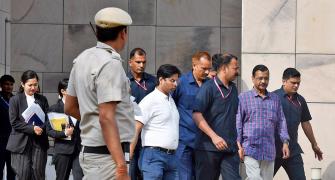It was a story of riches to rags.
Lady luck deserted investors and punters during 2008 with stock markets losing over Rs 40 trillion, a figure that not many would know carries how many zeroes.
Household names such as Tatas, Birlas and Ambanis, on whom small investors banked with their eyes shut, proved no guarantee for the safety of investment in the market where cumulative wealth of all listed companies got eroded by over 50 per cent during the year.
And analysts are predicting more troubled times ahead - at least till the first half of 2009.
The industry's who's who are a part of the club where each member lost tens of thousands of rupees during the story of boom to bust, but the misery of lakhs of individual and small investors is manifold more.
The lure of the stock market pulled in millions of investors during the boom period but for an overwhelming majority the story ended as a futile chase for a gold mine.
Baffling the investors and analysts alike, the market that started the year with benchmark Sensex touching an all time high of 21,206.77 points, began melting from mid-January in tandem with global bourses on weak cues from the US subprime crisis that surfaced late 2007.
The biggest public offer in India from Anil Ambani group company Reliance Power, which generated demand of Rs 7,50,000 crore (Rs 7,500 billion), fell flat on its face at the time of listing in February to accelerate the fall in secondary market, even though corporate India declared unheard of profits.
It was like a puzzle, even for the government which tried hard to re-instill the confidence in investors by saying time and again that fundamentals of the economy and market are good and they should not resort to panic selling.
A classic case of panic selling was witnessed in the case of ICICI Bank, where investors panicked by rumours that the largest private lender was going bust. The scrip, which peaked at over Rs 1400 a share, came to less than Rs 300 at one time.
The RBI and the government were pushed into an overdrive to assuage the fears that banking system in India was safe from the global meltdown - triggered by bankruptcy of Lehman Brothers in the US in September.
What could make it even more painful is that observers of the market, which has registered a full-year fall for the first time in seven years, do not see any immediate respite from the meltdown.
In the process, the total value of investors' holding in Indian stocks fell to just about Rs 30 trillion as the year 2008 drew to a close, from over Rs 72 trillion at 2007-end.
This included promoters taking a hit of more than Rs 20 trillion on their stock wealth, while foreign investors emerged as the second biggest loser class with a plunge of close to Rs 10 trillion on their portfolio.
Though smaller in comparison to the larger investor classes, retail investors also lost close to Rs 5 trillion -- which is possibly their biggest ever single-year loss.
Stung by the sharp erosion in their wealth, foreign investors pulled out more than $13 billion from the Indian stock market -- which is nearly three-fourth of over $17 billion they had invested in previous year.
On domestic front, the mutual funds saw their wealth plunging by nearly one-third or about Rs 1,50,000 crore (Rs 1,500 billion).Looking back at the year, Religare Securities president (equity) Amitabh Chakraborty said, "There has been shortage of liquidity across system, and emerging markets, including India saw close to $14 billion outflow. Besides, redemption pressure in domestic funds aggravated the selling.
"We went up too fast too soon and nobody believed that there ever could be a correction. Let us understand last year in 2007 there were investments of $17 billion and in 2008 there were sales of $14 billion -- no way markets could go up. Driving force is FII.
"Total equity investment of domestic mutual funds is under Rs 90,000 crore (Rs 900 billion)," Kejriwal Research and Investment Services managing director Arun Kejriwal said.
The year 2008 would be remembered for the 'yo-yo' ride the Sensex had as the Bombay Stock Exchange 30-share index climbed to its all-time intra-day high of 21,206.77 on January 10, and also witnessed its three-year low of 7,697.39 on October 27.
"When the initial signs of sub-prime started appearing in US markets from late 2007, the financial markets started anticipating its impact and sent the markets crashing from early 2008," SMC Global Securities director (merchant banking) Jagannadham Thunuguntla said.
Later on with Bear Stearns sell out overnight in April 2008, Lehman Brothers bankruptcy in September 2008, nationalisation of AIG/Fannie Mae/Freddie Mac in September 2008 have only validated the existing market fears.
Hence, even though the event of the crisis may appear to have happened in September 2008, market was discounting this since the beginning of the year, Thunuguntla added.
After their record investments in a single year of $17.4 billion in 2007, FIIs have pulled out as much as -- so far this year.
The indices fell because FIIs pulled out, domestic funds sold since the last three months and retail and high net worth individuals have sold wherever they had the leverage.
Big investment banks going bust with large proprietary books and P-note positions also added to the pressure, Religare's Chakraborty said.
Though the equity market losses have been astonishing, some signs of recovery can be seen at the end of the tunnel as Kejriwal said: "Recovery will happen only after the markets have reconciled to the slowdown after December quarter results are digested."
Similar thoughts were echoed by Chakraborty as well: "Flow to India will be affected negatively over the short term, but with dollar weakening, investors will soon start borrowing in dollar and investing in non dollar emerging market asset class. India will get a positive FII flow in 2009."
Chakraborty further added that 'today large cap blue chips are available at trough valuation.
One should build a portfolio as it is reasonable to believe that the market will be 20,000 in three years that is still double from the current level.
'Naturally individual stocks could return more than 100 per cent in 3-years.'
Bothra also noted that low valuations of blue-chops was certainly going to attract long-term investors, although any major surge in the markets might not be seen during 2009.
One message that was loud and clear from the year 2008 was that the decoupling theory was just a myth.
In the worlds financial architecture, emerging markets especially India is very much integral part of the structure.
India as a country, is not immune from the disease. However, we will recover faster from the disease.






